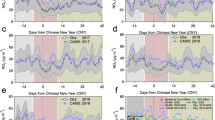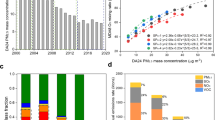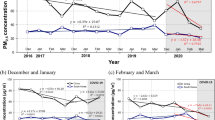Abstract
Near-surface ozone pollution, associated with complex responses to changing precursor emissions and meteorological conditions, has become one of the biggest challenges in China’s air quality management. Here, we present the spatiotemporal evolution of ozone concentrations from 2010 to 2021 using measurements of the national air quality monitoring network. We evaluate the effectiveness of the national air pollution control programme, including Phase 1 (2013–2017) and Phase 2 (2018–2021), in reducing the ozone level over China, using an optimized machine learning approach, high-resolution emission estimates and an improved air quality model. We find that while emission changes in Phase 1 increased the ozone level over the five highly developed regions, further reductions of nitrogen oxide emissions in Phase 2 have generally constrained the ozone pollution. The changing effect of emission controls on ozone pollution is due to the shift in the prevailing regime for ozone formation and the weakened effects of aerosol declines, as emission reductions continue. We further find that current emission controls have been more effective in rural locales in four of the five regions, and more effective in summer than winter. Therefore, further control of ozone pollution should consider these regional and seasonal variations to identify the most important precursors for the pollution.
This is a preview of subscription content, access via your institution
Access options
Access Nature and 54 other Nature Portfolio journals
Get Nature+, our best-value online-access subscription
$29.99 / 30 days
cancel any time
Subscribe to this journal
Receive 12 print issues and online access
$259.00 per year
only $21.58 per issue
Buy this article
- Purchase on Springer Link
- Instant access to full article PDF
Prices may be subject to local taxes which are calculated during checkout





Similar content being viewed by others
Data availability
The source data for figures (including the gridded data of MDA8 ozone concentration) are available at the figshare repository https://doi.org/10.6084/m9.figshare.23790609. Source data are provided with this paper.
Code availability
The code of the CMAQ model is available at https://github.com/USEPA/CMAQ/tree/5.2. The machine learning code used for predicting the ozone concentration is available at the figshare repository https://doi.org/10.6084/m9.figshare.23790609.
References
Li, K. et al. Anthropogenic drivers of 2013–2017 trends in summer surface ozone in China. Proc. Natl Acad. Sci. USA 116, 422–427 (2019).
Wang, T. et al. Ozone pollution in China: a review of concentrations, meteorological influences, chemical precursors, and effects. Sci. Total Environ. 575, 1582–1596 (2017).
Lu, X. et al. Exploring 2016–2017 surface ozone pollution over China: source contributions and meteorological influences. Atmos. Chem. Phys. 19, 8339–8361 (2019).
Liu, Y. & Wang, T. Worsening urban ozone pollution in China from 2013 to 2017 – Part 1: The complex and varying roles of meteorology. Atmos. Chem. Phys. 20, 6305–6321 (2020).
Circular of the State Council on Printing Out and Distribution of Action Plan on Air Pollution Prevention and Control Report No. Guofa [2013] 37 (in Chinese) (State Council of the People’s Republic of China, 2013); https://www.gov.cn/gongbao/content/2013/content_2496394.htm
Circular of the State Council on Printing Out and Distribution of Three-Year Action Plan on Defending the Blue Sky Report No. Guofa [2018] 22 (in Chinese) (State Council of the People’s Republic of China, 2018); https://www.gov.cn/gongbao/content/2018/content_5306820.htm
Zhang, Q. et al. Drivers of improved PM2.5 air quality in China from 2013 to 2017. Proc. Natl Acad. Sci. USA 116, 24463–24469 (2019).
Silver, B. et al. Substantial changes in air pollution across China during 2015–2017. Environ. Res. Lett. 13, 114012 (2018).
Fan, H., Zhao, C. & Yang, Y. A comprehensive analysis of the spatiotemporal variation of urban air pollution in China during 2014–2018. Atmos. Environ. 220, 117066 (2020).
Lu, X. et al. Rapid increases in warm-season surface ozone and resulting health impact in China since 2013. Environ. Sci. Technol. Lett. 7, 240–247 (2020).
Liu, Y. & Wang, T. Worsening urban ozone pollution in China from 2013 to 2017 – Part 2: The effects of emission changes and implications for multi-pollutant control. Atmos. Chem. Phys. 20, 6323–6337 (2020).
Li, M. et al. Rising surface ozone in China from 2013 to 2017: a response to the recent atmospheric warming or pollutant controls? Atmos. Environ. 246, 118130 (2021).
Zheng, B. et al. Changes in China’s anthropogenic emissions and air quality during the COVID-19 pandemic in 2020. Earth Syst. Sci. Data 13, 2895–2907 (2021).
Li, K. et al. Increases in surface ozone pollution in China from 2013 to 2019: anthropogenic and meteorological influences. Atmos. Chem. Phys. 20, 11423–11433 (2020).
Weng, X., Forster, G. & Nowack, P. A machine learning approach to quantify meteorological drivers of ozone pollution in China from 2015 to 2019. Atmos. Chem. Phys. 22, 8385–8402 (2022).
Shi, Z. et al. Abrupt but smaller than expected changes in surface air quality attributable to COVID-19 lockdowns. Sci. Adv. 7, eabd6696 (2021).
Zhang, Y. et al. Significant changes in chemistry of fine particles in wintertime Beijing from 2007 to 2017: impact of clean air actions. Environ. Sci. Technol. 54, 1344–1352 (2020).
Yin, H. et al. Unprecedented decline in summertime surface ozone over eastern China in 2020 comparably attributable to anthropogenic emission reductions and meteorology. Environ. Res. Lett. 16, 124069 (2021).
Sun, Y. et al. The drivers and health risks of unexpected surface ozone enhancements over the Sichuan Basin, China, in 2020. Atmos. Chem. Phys. 21, 18589–18608 (2021).
Li, C. et al. Elucidating contributions of anthropogenic volatile organic compounds and particulate matter to ozone trends over China. Environ. Sci. Technol. 56, 12906–12916 (2022).
WHO Global Air Quality Guidelines (World Health Organization, 2021); https://www.ghd.pku.edu.cn/docs/2021-09/2f00edbd847d4b3183f17393e43afa86.pdf
Gong, C. et al. A humidity-based exposure index representing ozone damage effects on vegetation. Environ. Res. Lett. 16, 044030 (2021).
Dang, R., Liao, H. & Fu, Y. Quantifying the anthropogenic and meteorological influences on summertime surface ozone in China over 2012–2017. Sci. Total Environ. 754, 142394 (2021).
Li, K. et al. A two-pollutant strategy for improving ozone and particulate air quality in China. Nat. Geosci. 12, 906–910 (2019).
Li, K. et al. Ozone pollution in the North China Plain spreading into the late-winter haze season. Proc. Natl Acad. Sci. USA 118, 422–427 (2021).
Lu, K. et al. Fast photochemistry in wintertime haze: consequences for pollution mitigation strategies. Environ. Sci. Technol. 53, 10676–10684 (2019).
Lu, X. et al. The underappreciated role of agricultural soil nitrogen oxide emissions in ozone pollution regulation in North China. Nat. Commun. 12, 5021 (2021).
Wu, R. et al. Reconciling the bottom-up methodology and ground measurement constraints to improve the city-scale NMVOCs emission inventory: a case study of Nanjing, China. Sci. Total Environ. 812, 152447 (2022).
Yang, J. et al. Co-benefits of carbon and pollution control policies on air quality and health till 2030 in China. Environ. Int. 152, 683–693 (2021).
Chen, Z. et al. Understanding the causal influence of major meteorological factors on ground ozone concentrations across China. J. Clean. Prod. 242, 118498 (2020).
Liu, P. et al. Effects of meteorological conditions and anthropogenic precursors on ground-level ozone concentrations in Chinese cities. Environ. Pollut. 262, 114366 (2020).
Liu, R. et al. Spatiotemporal distributions of surface ozone levels in China from 2005 to 2017: a machine learning approach. Environ. Int. 142, 105823 (2020).
Xiao, Q. et al. An ensemble machine-learning model to predict historical PM2.5 concentrations in China from satellite data. Environ. Sci. Technol. 52, 13260–13269 (2018).
Requia, W. J. et al. An ensemble learning approach for estimating high spatiotemporal resolution of ground-level ozone in the contiguous United States. Environ. Sci. Technol. 54, 11037–11047 (2020).
Kendall, M. G. & Stuart, A. The Advanced Theory of Statistics Vol. 3, 410–414 (Macmillan, 1983).
Nekola, J. C. & White, P. S. The distance decay of similarity in biogeography and ecology. J. Biogeogr. 26, 867–878 (1999).
Xing, J. et al. The quest for improved air quality may push China to continue its CO2 reduction beyond the Paris Commitment. Proc. Natl Acad. Sci. USA 117, 29535–29542 (2020).
Hong, C. et al. Impacts of climate change on future air quality and human health in China. Proc. Natl Acad. Sci. USA 116, 17193–17200 (2019).
Emery, C. et al. Recommendations on statistics and benchmarks to assess photochemical model performance. J. Air Waste Manag. Assoc. 67, 582–598 (2017).
Witte, J. C. et al. The unique OMI HCHO/NO2 feature during the 2008 Beijing Olympics: implications for ozone production sensitivity. Atmos. Environ. 45, 3103–3111 (2011).
Jin, X. & Holloway, T. Spatial and temporal variability of ozone sensitivity over China observed from the Ozone Monitoring Instrument. J. Geophys. Res. Atmos. 120, 7229–7246 (2015).
Jin, X. et al. Inferring changes in summertime surface ozone-NOX-VOC chemistry over US urban areas from two decades of satellite and ground-based observations. Environ. Sci. Technol. 54, 6518–6529 (2020).
Wang, W. et al. Spatial and temporal changes of the ozone sensitivity in China based on satellite and ground-based observations. Atmos. Chem. Phys. 21, 7253–7269 (2021).
Pusede, S. E. & Cohen, R. C. On the observed response of ozone to NOX and VOC reactivity reductions in San Joaquin Valley California 1995–present. Atmos. Chem. Phys. 12, 8323–339 (2012).
Seyedali, M. et al. A comprehensive investigation of surface ozone pollution in China, 2015–2019: separating the contributions from meteorology and precursor emission. Atmos. Res. 257, 105599 (2021).
He, Q. et al. Spatially and temporally coherent reconstruction of tropospheric NO2 over China combining OMI and GOME-2B measurements. Environ. Res. Lett. 15, 125011 (2020).
Geng, G. et al. Tracking air pollution in China: near real-time PM2.5 retrievals from multisource data fusion. Environ. Sci. Technol. 55, 12106–12115 (2021).
Acknowledgements
This work is supported by the National Natural Science Foundation of China (41922052 to Y.Z. and 42177080 to Y.Z. and Y.W.) and the Sze Family Charitable Foundation to C.P.N.
Author information
Authors and Affiliations
Contributions
Y.Z. and Y.W. designed the research. Y.W. performed the research. Yiming Liu, Yang Liu, Y.J., J.X. and C.P.N. interpreted the data. B.Z. provided emission inventory. S.W. provided observational ozone data. Y.W., Y.Z. and C.P.N. wrote the paper with input from all co-authors.
Corresponding author
Ethics declarations
Competing interests
The authors declare no competing interests.
Peer review
Peer review information
Nature Geoscience thanks the anonymous reviewers for their contribution to the peer review of this work. Primary Handling Editor: Xujia Jiang, in collaboration with the Nature Geoscience team.
Additional information
Publisher’s note Springer Nature remains neutral with regard to jurisdictional claims in published maps and institutional affiliations.
Extended data
Extended Data Fig. 1 Time series and interannual trends of MDA8 ozone concentrations for East China during 2010–2012, 2013–2017 and 2018–2021 for urban (a) and rural areas (b).
The smooth grey lines and dotted purple lines represent time series of predicted and observed MDA8 ozone averaged for each month, respectively. The black, blue and red lines represent the linear trends of MDA8 ozone for 2010–2012, 2013–2017 and 2018–2021, respectively. The annual variation rates (μg/m3/yr) during different periods, with significance levels (*p < 0.05) are presented (The numbers in the parentheses indicate the relative annual variation rate (%/yr)). Summer indicates June-August and winter indicates December-February.
Extended Data Fig. 2 The difference in CMAQ-simulated MDA8 ozone for East China due to the anthropogenic emission change from 2013 to 2017 (a) and 2018–2021 (b).
The meteorological field is fixed at 2017 level in the simulation.
Extended Data Fig. 3 The relationships between MDA8 ozone, satellite-based NO2 and HCHO TVCD in the five key regions for selected years during 2013–2021.
MDA8 ozone are predicted with machine learning model in this work, and NO2 and HCHO TVCD are obtained from OMI products (see Methods of the article). The solid, dashed and dotted lines indicate the HCHO/NO2 ratio at 1, 2 and 4.
Extended Data Fig. 4 The growth of MDA8 ozone-PM2.5 partial correlation coefficients (PCORs) and the decline in PM2.5 concentrations for the five key regions during 2013–2021.
The solid blue lines and solid green lines indicate the time series of MDA8 ozone-PM2.5 PCORs and PM2.5 concentrations, respectively. The dashed blue lines indicate the linear trends of MDA8 ozone-PM2.5 PCORs. The annual growth rates of PCORs with significance levels (*p < 0.05) are presented.
Extended Data Fig. 5 Spatial distribution of the simulated MDA8 ozone (μg/m3) responding to the changes in the effects of aerosol in summer from 2013 to 2021.
The aerosol affects ozone via altering photolysis rates (a) and all heterogeneous reactions (b).
Extended Data Fig. 6 The differences in winter (December) MDA8 ozone simulated with and without the aerosol effect in CMAQ are presented for 2013 (a), 2017 (b), and 2021 (c).
The national average ‘efficiency’ of aerosol suppression on MDA8 ozone (that is, ΔCO3/CPM2.5) is given in the bottom left corner of each panel.
Extended Data Fig. 7 Expanded ozone pollution seasons in China.
The evolution of monthly average MDA8 ozone concentrations (a), and monthly distributions of satellite-derived TVCD of HCHO (b) and NO2 (c) during 2010–2021 are shown for East China. The data source of TVCD is described in the Methods of the article.
Supplementary information
Supplementary Information
Supplementary Text Section, Figs. 1–18 and Tables 1–9.
Source data
Source Data Fig. 1
Gridded data of average warm-season MDA8 ozone concentration during 2010–2021.
Source Data Fig. 2
Interannual changes of MDA8DEMET in urban and rural areas for different regions for 2013–2021.
Source Data Fig. 3
Annual variation rates of MDA8DEMET for Phase 1 and Phase 2 at monthly scale over different regions.
Source Data Fig. 4
Gridded data of shifts in ozone formation regime between 2013 and 2021 for different regions and seasons; the fractions of total area undergoing different types of regime shift by season for the five key regions.
Source Data Fig. 5
Gridded data of the effect of aerosol reduction on ozone enhancement.
Source Data Extended Data Fig. 1
Interannual changes of MDA8 ozone concentrations for East China during different periods for urban and rural areas.
Source Data Extended Data Fig. 2
Gridded data of the difference in CMAQ-simulated MDA8 ozone for East China due to the anthropogenic emission change from different periods.
Source Data Extended Data Fig. 3
MDA8 ozone, satellite-based NO2 and HCHO TVCD in different regions and years.
Source Data Extended Data Fig. 4
Partial correlation coefficients of MDA8 ozone-PM2.5 and the PM2.5 concentrations for the five key regions during 2013–2021.
Source Data Extended Data Fig. 5
Gridded data of simulated MDA8 ozone concentrations responding to the changes in aerosol effects in summer from 2013 to 2021.
Source Data Extended Data Fig. 6
Gridded data of the differences in winter MDA8 ozone simulated with and without the aerosol effect in CMAQ model.
Source Data Extended Data Fig. 7
Monthly average MDA8 ozone concentrations and satellite-derived TVCD of HCHO and NO2 during 2010–2021 for East China.
Rights and permissions
Springer Nature or its licensor (e.g. a society or other partner) holds exclusive rights to this article under a publishing agreement with the author(s) or other rightsholder(s); author self-archiving of the accepted manuscript version of this article is solely governed by the terms of such publishing agreement and applicable law.
About this article
Cite this article
Wang, Y., Zhao, Y., Liu, Y. et al. Sustained emission reductions have restrained the ozone pollution over China. Nat. Geosci. 16, 967–974 (2023). https://doi.org/10.1038/s41561-023-01284-2
Received:
Accepted:
Published:
Issue Date:
DOI: https://doi.org/10.1038/s41561-023-01284-2



